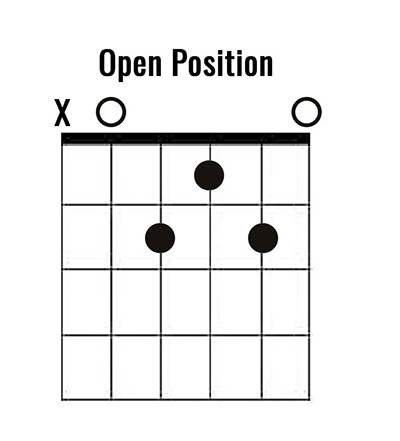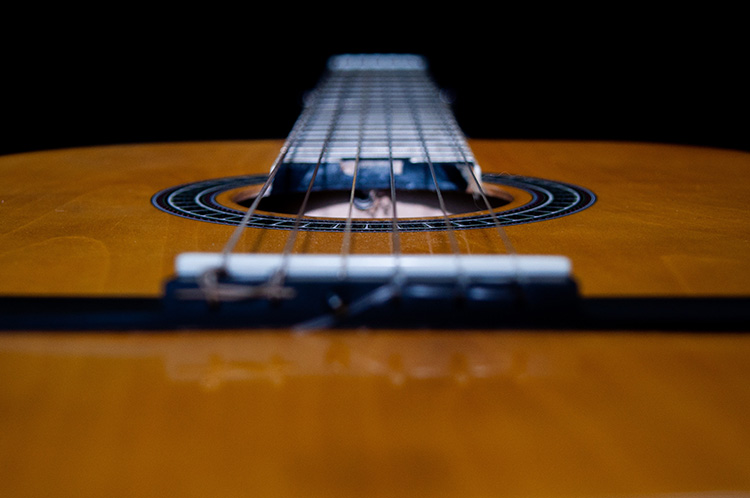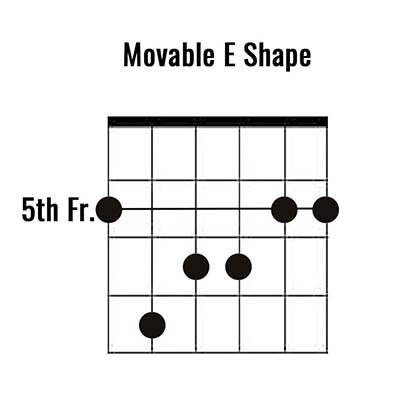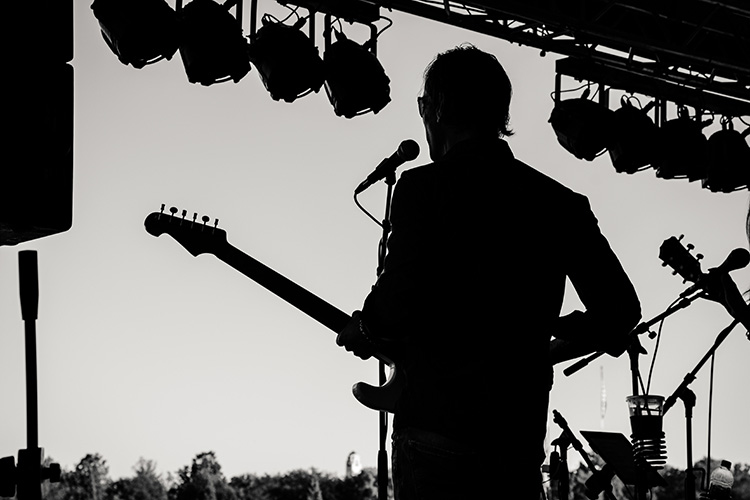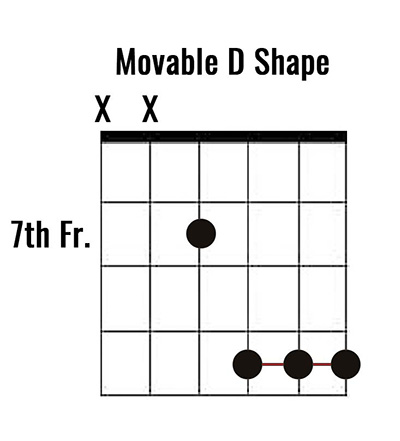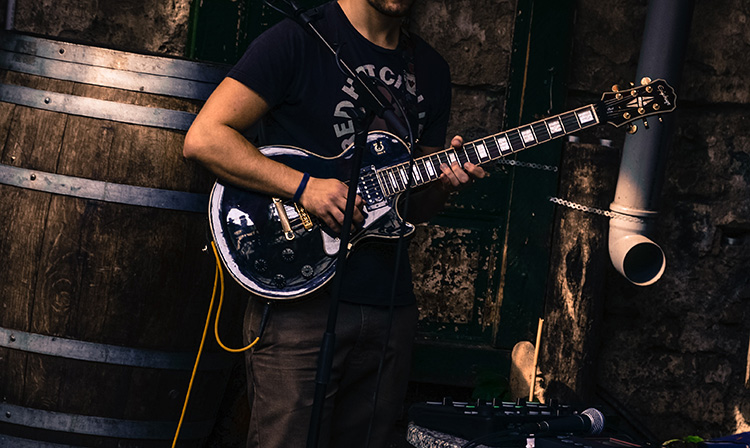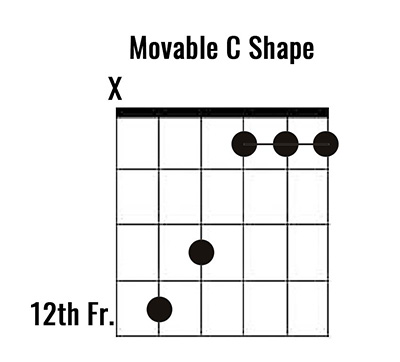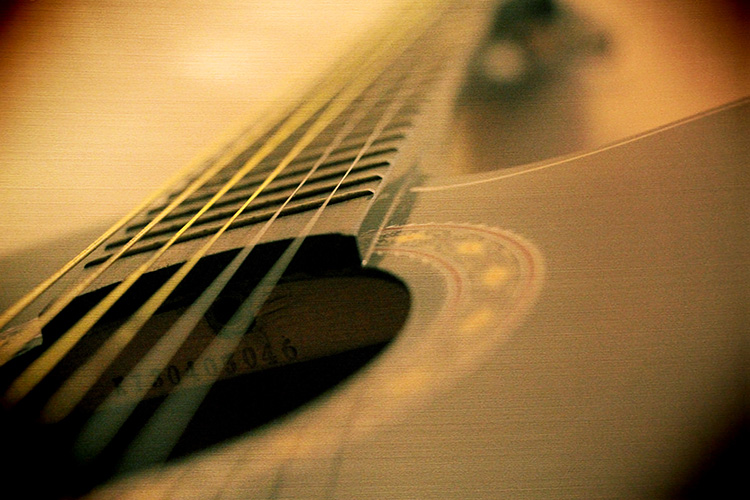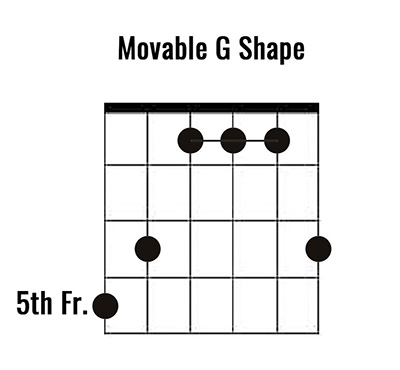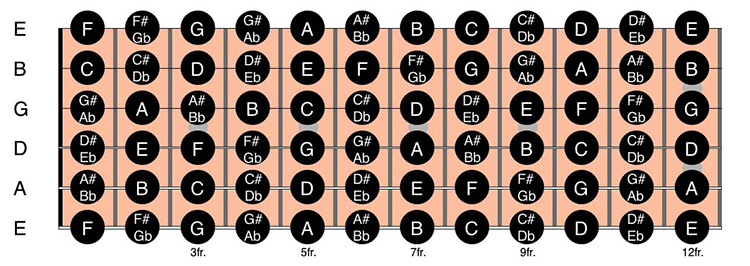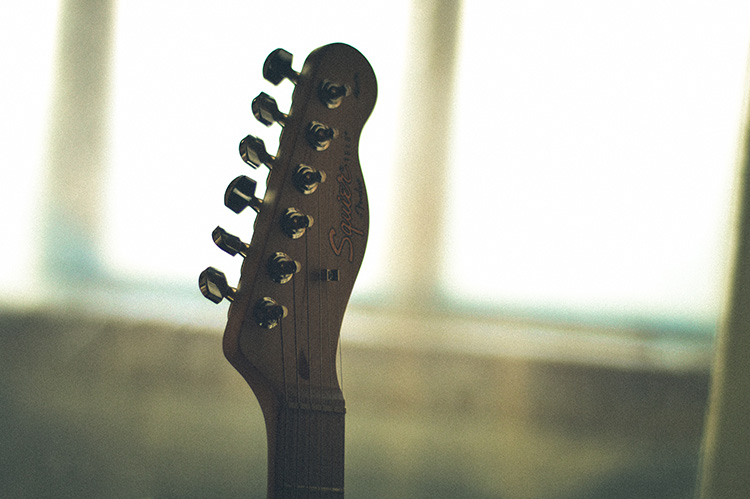The Amaj7 guitar chord is one of the coolest guitar chords out there. In this lesson we’ll show you 9 of our favourite voicings for this chord.
Over 250,000 guitar-learners get our world-class guitar tips & tutorials sent straight to their inbox: Click here to join them
In this free lesson you will learn:
- 9 essential ways to play the Fmaj7 guitar chord.
- 3 quick & easy tips that will make your chords sound amazing.
- The top-secret tip that will allow you to use Amaj7 in ANY musical situation.
What is the Amaj7 guitar chord?
The Amaj7 guitar chord is a great alternative in many scenarios to using a basic major chord.
- Amaj7 is used heavily in Jazz because of its beautiful chord definition.
- This chord sounds like a summer’s day, and adds a gorgeous layer of brightness to any chord progression.
- The Amaj7 guitar chord can also be found in ballads for the same reason, as well as Pop music.
As you will discover, this chord contains four notes instead of the typical three that we see.
This brings a new level of definition to our chords, and the principle of this fourth note can be applied to almost any chord we already know.
Let’s take a closer look at why the Amaj7 guitar chord is so great to have in your musical toolkit.
The Amaj7 Guitar Chord – Open Position
The open position is always the best starting point for learning a new chord.
- This is because the open position gives us the chance to use open strings as part of the chord, lessening the initial strain on our forearm and hand.
- The Amaj7 guitar chord sounds lush and beautiful in the open position.
- Take the time to play an arpeggio of the chord to hear each note individually. This will help you train your ears to recognize chords and their notes better.
Skill Tip: If you’re having trouble playing a chord, play it in smaller fragments and build up to it.
If you’re playing Amaj7 in the open position, start by playing two strings, then three, then the whole chord. Slow and steady wins the race!
The easiest way to play structure your fingers for the Amaj7 guitar chord in this position is as follows:
A String: Open
D String: Middle finger (2nd fret)
G String: Index finger (1st fret)
B String: Ring finger (2nd fret)
High E: Open (optional)
Remember to experiment with finger positions to find the one that works best for you and your hands.
- Everybody is different, and finding a comfortable position for yourself is extremely important.
- Never sacrifice comfort for the sake of a good chord – Instead, find a way to play it that suits you!
Now let’s move on to ‘movable’ versions of the Amaj7 guitar chord.
Learn 12 EASY beginner chords with our popular guide

✅ Stop struggling. Start making music.
✅ Learn beginner-friendly versions of every chord.
This is our most popular guide and it will improve your chord ability quickly! 😎
Get your own personalised guitar-learning plan 🎸
Get a custom guitar-learning plan here: Click here for GuitarMetrics™
World-Class Guitar Courses 🌎
Learn from the world's best guitar educators: Click here for our guitar courses
The Amaj7 Guitar Chord – Movable E Shape
If you haven’t heard of movable chords, they’re quite simple:
- Movable chords are chords that have shapes that can be easily moved around into other keys without changing our fingering.
- Once we master them, they also make switching to other chords much easier.
With that in mind, these chords are definitely worth practicing frequently.
We refer to this shape as a “movable E” shape, because it resembles the shape of an Emaj7 chord if we moved the shape to the open position.
Let’s have a look:
- We’ve included the full version of this chord for you to play, but playing the B and high E strings is optional.
- This is because these two strings simply recycle notes that have already been used in the lower register of the chord.
We can play it using four fingers as shown below:
Low E String: Index finger (5th fret)
A String: Pinky finger (7th fret)
D String: Middle finger (6th fret)
G String: Ring finger (6th fret)
The Amaj7 Guitar Chord – Movable A Shape
The Amaj7 guitar chord itself is also a movable chord shape, and is one of the easier ones to play if you’ve already become familiar with barre chords.
In order to understand what other chords can be played with this shape, we need to understand the order of the notes on the A string.
Understanding how the notes progress on the A string also gives us the clearest display of the full octave from A to G# up the fretboard.
If you’re looking to understand more about the progression of notes on the guitar, start with the A string.
Skill Tip: Playing the Amaj7 guitar chord in different positions can give us a nice jazz sound.
Try this: Play your open position Amaj7, then move to a different position with the same chord shape.
Try going from the open position to the fourth fret (C#maj7), then back to the second fret (Bmaj7). Sounds nice, right?
This may seem like a stretch at first if we’re new to guitar but taking it slow and practicing effectively will help us play the Amaj7 guitar chord in no time.
The Amaj7 Guitar Chord – Movable D Shape
The next movable shape of Amaj7 is the D shape we refer to it as the D shape such because of how it resembles a Dmaj7 chord in the open position.
- This shape takes us a bit higher up the fretboard to the 7th fret on the D string (which makes it easier to remember.)
- This brings us into the higher register of the guitar, so you will notice that this version of Amaj7 will sound significantly ‘brighter’ in tone than the two shapes we’ve already seen.
Check out the chord shape below:
This shape is a little less complicated to play than the movable E shape above, and the higher voicing of the chord gives it a nice shine on the top notes.
You could play this shape of the Amaj7 guitar chord with four fingers. It is far easier however (in the long run) to barre your ring finger across the G, B and high E strings.
Try it both ways and see what works for you. If you want to play this version of the Amaj7 guitar chord with four fingers, we recommend playing it like this:
D String: Index finger (7th fret)
G String: Middle finger (9th fret)
B String: Ring finger (9th fret)
High E: Pinky finger (9th fret)
Amaj7 Guitar Chord – What’s different about it?
For this section, we’re going to look at how this chord is constructed.
First, we need to look at all of the notes in the A major scale to understand what notes are being used.
The notes of the A major scale are as follows:
A (I) – B (II) – C# (III) – D (IV) – E (V) – F# (VI) – G# (VII)
Amaj7 is made up of four notes:
A – C# – E – G#
With this in mind, we can understand that this chord is made up of the first (I), third (III), fifth (V) and seventh (VII) scale degrees of the A major scale.
While our typical major chord is made up of three notes (I, III & V), the addition of this extra note (the VII) is what colours the Amaj7 guitar chord differently.
- This is why we add the ‘7’ in the name Amaj7.
- Major 7 chords can also ‘pull’ us toward other chords when played together, which creates a great dynamic in a chord progression.
- Try playing D major and then Amaj7 and see how Amaj7 pulls you back to the sound of D major.
Now that we know how it works, let’s play it!
The Amaj7 Guitar Chord – Movable C Shape
This shape is what we refer to as a “partial barre chord.”
- All this means is that we are barring strings with our index finger – just not all of the strings.
- The Amaj7 guitar chord sounds open and clear all the way up at the 12th fret on the A string, where we start our movable C shape.
- This is an unorthodox shape, but a handy one to learn as it starts with the pinky finger.
If you haven’t warmed your pinky finger up too much yet, that’s okay – Play the chord in portions until you’re ready to tackle the whole thing!
Similar to the open position, the high E string is optional in this shape, which makes things much easier if we’re just starting out.
We can position our fingers like this:
A String: Pinky finger (12th fret)
D String: Ring finger (11th fret)
G & B Strings: Index finger (9th fret)
High E: Index finger (9th fret) (optional)
Skill Tip: Focus on making the B and G strings ring out together with your index finger before moving on to the full chord. This makes it a lot easier to conquer this shape, as your index finger will be carrying most of the load here.
The Amaj7 Guitar Chord – Movable G Shape
Let’s take a side note for a second on movable chord shapes before we continue:
- The names of these movable chord shapes can be mildly subjective depending upon who you talk to.
- When it comes to understanding music theory, many musicians can have slightly different perspectives on the names of chords they play.
The principle of these movable shapes in this article is based on the CAGED system – more on that here.
Let’s have a look at the movable G shape of this chord:
The movable G version of the Amaj7 guitar chord provides a good stretch for the hands.
Because this shape spans all six strings, we’re going to have to barre with our index finger.
Check out the layout below for the best way to position your hand:
Low E: Pinky finger (5th fret)
A String: Ring finger (4th fret)
D, G & B Strings: Index finger (2nd fret)
High E: Middle finger (4th fret)
- Take your time with this one and don’t be afraid to work on it in sections at a time.
- With this chordal shape, don’t feel like you have to play every part of this chord.
- If you want to simplify it, you can just play the top 4 strings.
The Amaj7 Guitar Chord – Inversions
One of the more advanced things that we can do with the Amaj7 guitar chord is to invert the order of notes.
- Inversions are just that – The same chord with the same notes played in a different order.
- Although inversions contain the same notes, they can colour the chord differently.
- Inversions also help us see different possibilities on the fretboard and aid in the development of our “mental map” that helps us remember where the notes are.
Let’s take a look at the fretboard to see exactly how many places the notes A, E, C# and G# can be played together in close proximity.
There’s a lot right? Learning where each of these notes are, can be hugely beneficial for your fretboard knowledge.
Challenge Yourself: There are many different combinations for playing the Amaj7 guitar chord. Use the fretboard map above to help find as many different possibilities as you can.
Take note of how different each inversion sounds when using a different note of the chord as the root.
- When we “root” the Amaj7 guitar chord on G#, it creates a dark and dissonant sound.
- When we root it on C#, it creates a mysterious sound instead. Rooting Amaj7 with an E will give us a more somber tone.
How To Master the Amaj7 Guitar Chord
Now that we’ve covered what the Amaj7 guitar chord is and how to play it, we can tackle the most important topic of all when it comes to music:
Mastery.
- Mastery is important because it takes our practice and turns it into knowledge, but mastery can only be achieved through practice.
- One of the best ways to master the Amaj7 guitar chord is to practice it across the fretboard.
Making use of movable shapes is a great way to get to know every place that a chord pops up (and there are several when you break it down)
Aside from practicing movable shapes, playing arpeggios help us boost both our playing and our knowledge at once.
- Arpeggios are simply chords that are broken down into individual notes.
- Playing chords this way not only helps to bring out the character of each note, but it gives our ears better exposure to what the chord sounds like.
- Playing arpeggios helps us with picking accuracy, fret accuracy and dexterity. It also helps the left and right hands learn to work more fluidly together.
Arpeggios and chords should be part of our everyday practice regimen as often as possible, as they do wonders for every part of our guitar playing.
Where do I go from here?
Want to progress to the next level? We highly recommend doing the following:
- Working chords and arpeggios into your practice regimen and practicing them often.
- Singing the notes of the chords you are practicing to develop your ear
- Practicing these chords with your teacher
- Beginner players: Pick up a copy of Hal Leonard’s Guitar Chords Deluxe
- Intermediate players: Pick up a copy of Joe Pass’ Guitar Chords Book and practice your inversions. This book teaches us how guitar chords share the same notes, and how we can look at chords in different ways. Open with caution, but be prepared for a world of knowledge.
Recommended Resources
If you’re looking for more guitar knowledge, check out some more of our free resources
- A Minor Chord For Beginners
- Three Easy Ways to Play The A Chord on Guitar
- A7 Guitar Chord
- How to Play the A Bar Chord
- Am7 Guitar Chord: 6 Ways to Play this Chord
What Type of Guitarist Are You?
Take our 60-second quiz & get your results: Take The Quiz
Join the world's best online guitar school 🌎
- Get your own personalised guitar learning plan (customised just for YOU).
- World-class online guitar courses. Learn at your own pace.
- Community Campus & Learning Forum - A friendly community! Connect with our team & students. 😊
- Beginner Song library with chordsheets, tabs and tips. (Songs suitable for all levels!)
- Regular live streams, seminars and Q&A sessions - Learn from world-class guitar educators. Get all your questions answered!
Click here to learn more about National Guitar Academy membership 
Cool Guitar T-shirts 😎
Look cooler! Check out our merch: Click here to see our merch store
Want free guitar tips and video lessons delivered to your inbox?
Join over 250,000 other guitar learners and subscribe to our guitar-tips-by-email service. (It's free.)
We'll send you a series of lessons that will move you to the next level of your guitar journey.
Learn how everything fits together quickly, easily and effectively. We share ninja tips (for instant fun!) but also timeless fundamentals that will deepen your understanding.

Popular Lessons
How To Learn Guitar: An 11-Step Programme For Beginners
How To Choose The Perfect Beginner Guitar
More Cool Guitar Stuff
Learn about National Guitar Academy: About Us
Visit our YouTube channel for fun guitar videos.
Join us on Facebook for daily guitar tips.
Listen to our Learn Guitar Podcast for rapid guitar progress.
Check out our free chord lessons.
Get our best guitar tips & videos
Where should we send it?
Get our best guitar tips & videos


